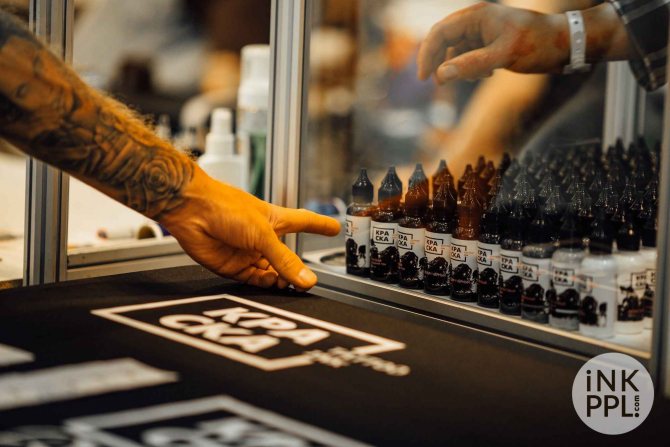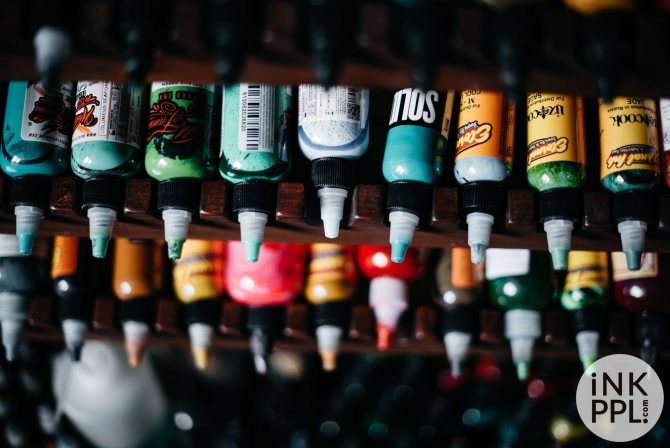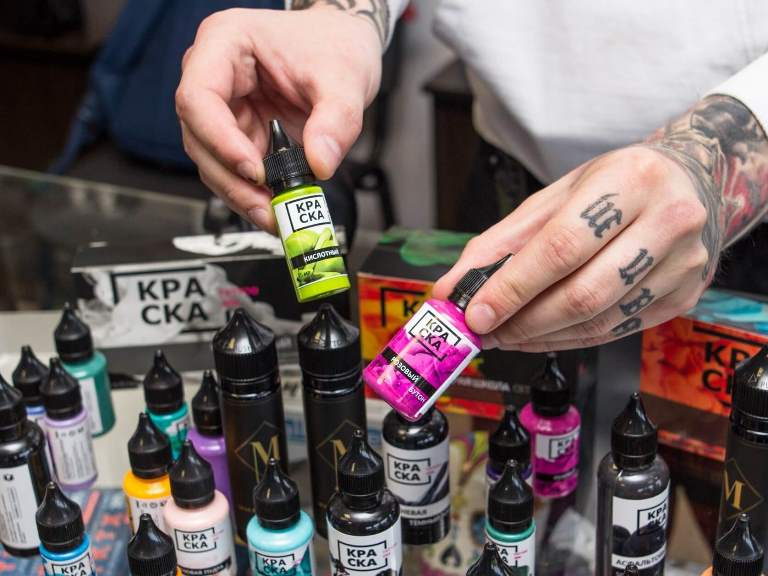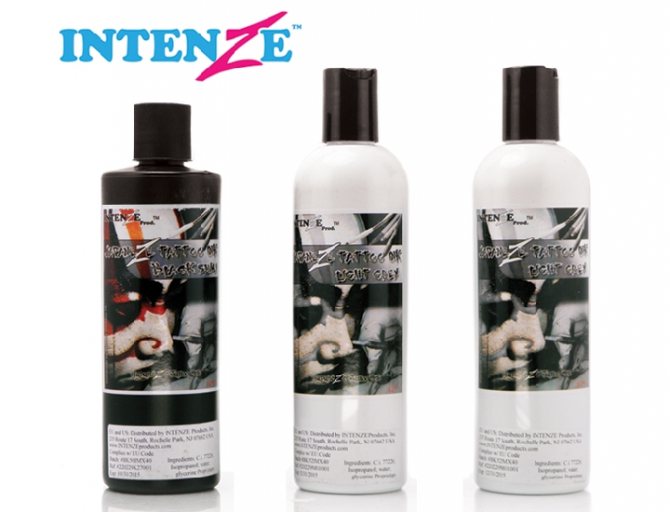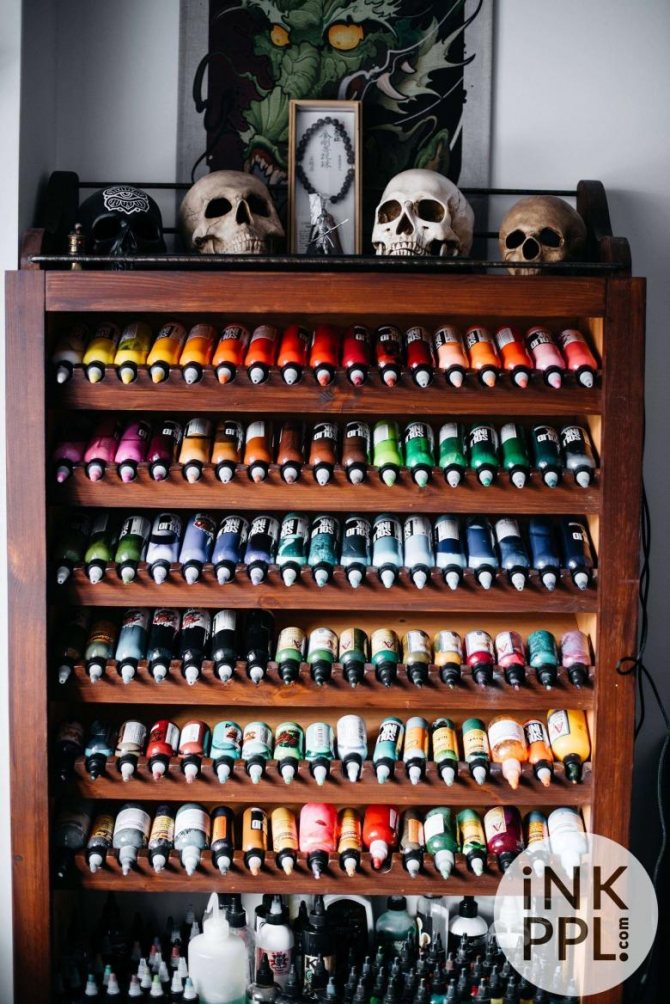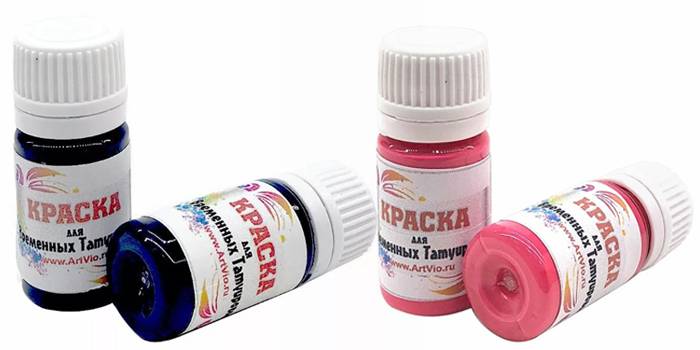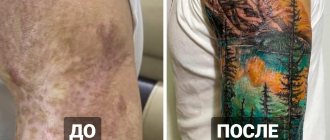The composition of paint for tattoos
Tattoo ink is a coloring pigment, whose composition with the era of the birth of tattoo culture has undergone dramatic changes. Previously, dyes were created from oxides of various metals, chemical additives to increase brightness and resistance to fading. Mixing of several tattoo pigments allows to get new unusual shades and also to optimize certain properties of dyes. While in the past black pigment was created from soot and wood, white from lead and red from rust, today everything is different.
Modern tattoo pigment consists of:
- chemically synthesized dye, completely safe and hypoallergenic;
- Diluent, whose task is to evenly distribute the dye in the dermis (glycerin, propylene glycol, ethyl alcohol).
Alexander Mosolov, about tattoo pigments firsthand
Today we are with Alexander MosolovThe founder of the first Russian brand for the production of tattoo ink - KRASKA Tattoo Ink. It is amazing but even in the modern information overloaded world still tattoo pigments cause a lot of questions both from clients and from tattooists themselves.
Let's try to figure out together what tattoo ink is and how to work with it.
When we talk about the production of tattoo ink, the first question that arises is: How exactly does the manufacturer choose the dye pigments?
- From a chemical point of view, the degree of purification/purity of the raw material is very important. For example, a pigment with the same color index from different manufacturers can be as pure and safe as with a huge amount of impurities of salts, heavy metals, arsenic in the end. Of course one has to investigate the raw material before starting work with a supplier and afterwards to analyze the ready production on all positions of State Standard requirements on tattooing.
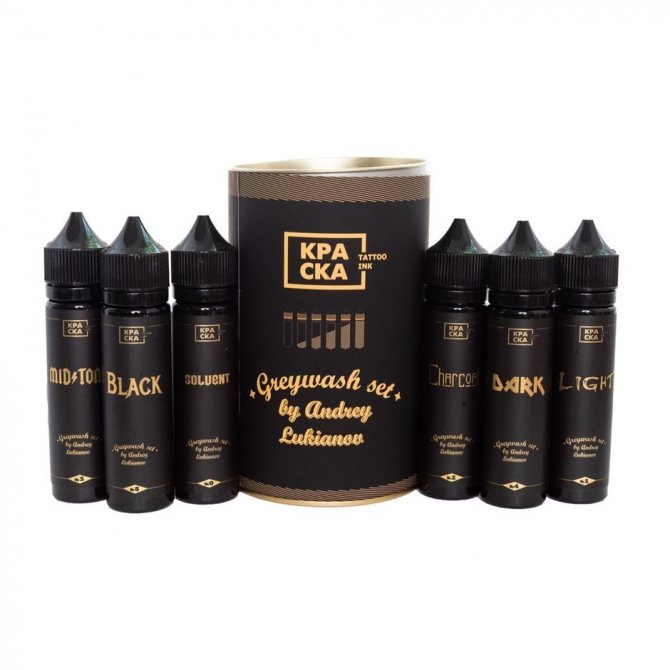
From the physical point of view all is also interesting, and there are very important both the particle sizes of pigment and its optical properties. For example, different grades of carbon - when the particles are relatively large, it behaves more stable in the skin over time, but the color is more gray. And too small particles, although they give the intensity of color, over time are blurred or partially eliminated by the body, and such tattoos look deplorable over time. Remember how yellow pigment disappears from some tattoos... We have to take these parameters into account to achieve certain properties of BRAIN.
What about allergies to certain pigments? What do the statistics look like for pigment colors and the frequency of allergic reactions in people? And do you have any advice on what a person should do if they have an allergic reaction?
- Oh-oh-oh, a lot of people have already broken many spears about this question... Different colors and formulations have different chances of allergies, so everything is ambiguous. For example, black colors have almost no complications, but the red spectrum is in the risk zone and there are different reactions. What people call "allergies" are actually not always allergies, they can be chemically toxic burns, just inflammation, and sometimes an infection from poor care. There can be no recommendations, every treatment has to be targeted and with the participation of a dermatologist at least.
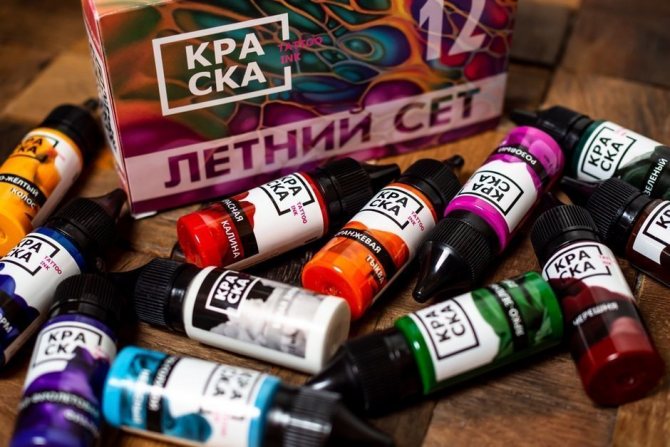

Every tattooist sooner or later faces the question: What is the main difference between the brands on the market? Can you elaborate on that a bit more?
- Of course - these are such obvious qualities as responsible approach and quality of product itself. As with any product, tattoo dyes have a spectrum of manufacturers from the cheapest Chinese noonemes to the really cool manufacturers.
In general, in terms of formulations, provided a quality pigment is used, I would divide into two categories: 1 - on resins (rosin; acrylic rosin; proprietary rosin) 2 - on copolymers (co-polymer). It's like the 20th century vs. the 21st century. These binders are needed for the pigment particles to mix well with water. Most companies now traditionally work on resins.
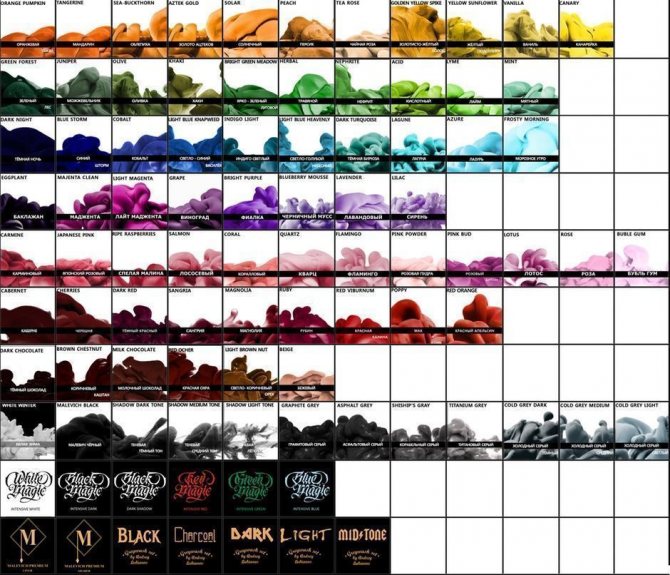

- Personally, as a developer, I consider copolymeric formulations to be more promising and safer for the skin and body. Everybody knows that water-soluble synthetics, as a rule, have greater stability and shelf life, and they also open up unprecedented opportunities - for example, due to different lengths of copolymer molecular chains one can regulate flow and pigment penetration, and the paint does not stack permanently at the bottom of the can.
And resins, in turn, are unstable in aqueous media - simply put, most resins curdle in water. And under the chemical number rosin, we find a deciphering of "rosin"... Hence, additional stabilizers and preservatives in the compositions, as well as recommendations of manufacturers not to mix with water. And yes, rosin is prohibited for use in food and cosmetic products in the territory of the Customs Union, which in turn suggests additional thoughts.
There is also a constant joke in the air that paints have up to 75% distilled water and by and large resellers take water across the ocean.
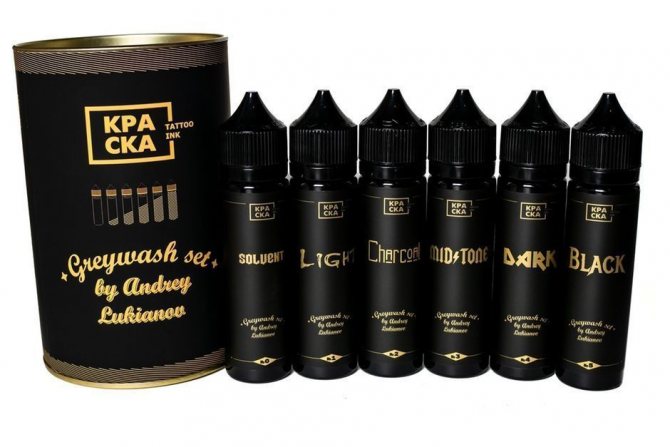

What is Tattoo Ink good for?
- I try to work with medium and coarse dispersion pigment brands. These pigments are a little harder to beat in, but the result is very durable. After a few years, you see your work and it's right there!
Also our colors are thick which means high concentration of pigments.
Our paints are thick - this speaks for the high concentration of pigments. We also managed to prevent the color from drying out while working and it stays in bubbles as long as possible even if used infrequently.
The safety and positive qualities of copolymers I tried to explain above, but this is a worthy topic for a separate article, but in addition I would like to highlight: - KRASKA contains no preservatives; - Confirmed chemical and microbiological purity, all laboratory tests are on our official pages; - More than 700000 tattoos by tag #kraskatattooink; - Availability in all tattoo stores; - Price.
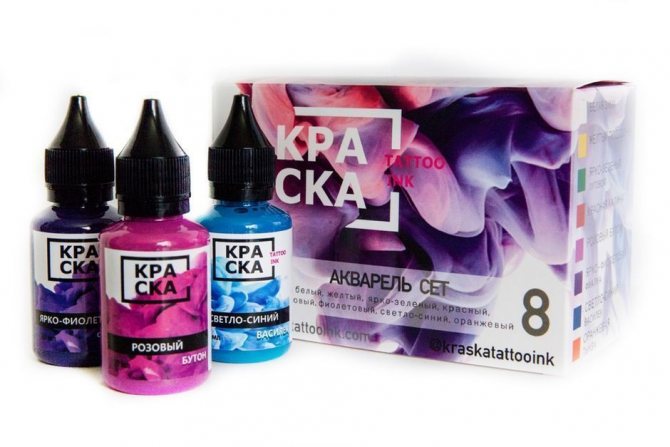

What about compatibility with other brands of tattoo ink? Can your pigments be mixed with any others?
- In practice, everything has always been mixed and with everything, and as a rule everything is fine. A good artist still forms a working set of favorite shades from different manufacturers, for example I like purple from one company, and red and pink from another ... Just because I like it so ...
And in conclusion I would like to hear advice from the professional on storage of tattoo inks because many masters still do not know how exactly inks should be stored so that they remained suitable for use throughout their shelf life.
- Certainly it is desirable to store in dry conditions and to protect from direct sunshine, paints on resins and it is not recommended to freeze which imposes restrictions at shipment and transportation.
Before using, be sure to shake the jar well. If it has been standing for a thousand years and has dried up, you'd better buy a new one.
During the session in any case do not pour into the capes grabbing the vial in bloody work gloves, only with clean hands!


Black Paint for Tattooing or Ornamentation
Black pigment is a tattoo classic, perhaps the most sought after and frequently used dye. When choosing black paint for body ornaments, inscriptions, bright, contour lines of complex drawings, it is necessary to pay attention to a number of characteristics:
- hypoallergenic and non-toxic;
- durability and color saturation;
- the purpose of the dye - there are pigments for the application of the contour (marked "line") and for painting, and there are also universal paints that combine both options.
Types of pigments
Plastic microgranules - the most expensive version of the pigment, but it gives the most vivid and saturated color, and retains its original appearance for a long time.


Mineral pigments are quite often used by professional tattoo artists because they have a number of undeniable advantages. Most of them are zinc and iron oxides. Their main advantages are:
- the inability to affect lymphatic and fat cells, due to which the migration of ink beyond the contour of the tattoo is excluded;
- very rich color that does not change after insertion into the skin;
- hypoallergenic;
- economical consumption due to optimal consistency;
- Rarely enough in the tattoo industry dyes of vegetable and organic origin are used. This is due to a number of negative properties of such pigments. The main one is the ability of the paint to dissolve to the end, and thus spread far beyond the tattooed area. In addition, unlike mineral pigments, vegetable pigments can provoke allergic reactions.
Another significant disadvantage of organic paints is the change of color under the influence of the sun, which, of course, is extremely undesirable for the owner of the tattoo.
Is the paint safe for the body?
Contrary to popular belief, organic pigments made from natural vegetable ingredients can cause allergic reactions in humans. But the chemical elements are absolutely safe. All compounds injected under the skin are inert. That is, they do not enter into further reactions with other elements.
However, it should be remembered that every organism is different. Therefore, if you have concerns, it is better to test the paint on a small area of the skin. If after a day from the time of application there is no itching, burning, redness, bloating or rash, you can safely apply the paint.
How safe are the dye pigments
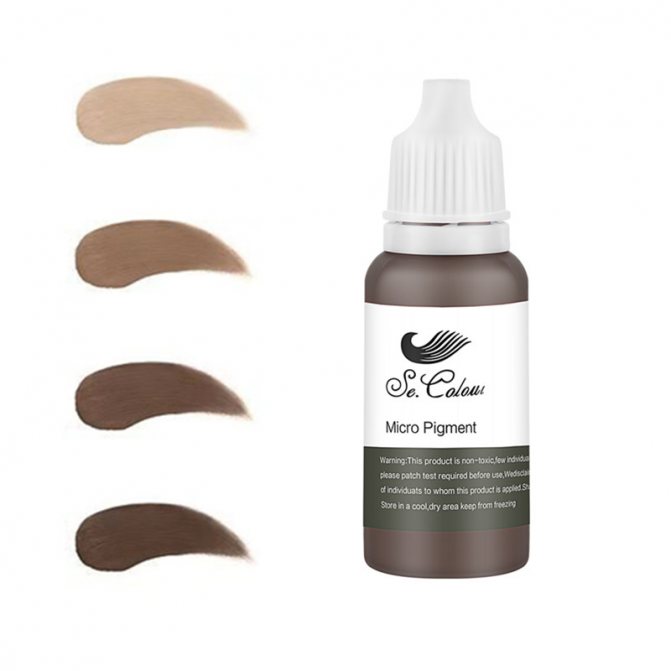

In any cosmetic composition there are dangerous to the health of the skin, components. The thing is that their quantity can be different, some will contain a minimal amount of such substances, which are not able to harm the body, others will contain much more of them, which will cause negative effects.
The quality of the work done is influenced by the skill of the beautician and the accuracy of the woman's following care recommendations.
In order not to doubt the safety of the applied dye, it is necessary to clarify before the procedure that there are certificates for the chosen substance and to check their conformity. In these documents, you can clarify the country where the composition was produced, as well as the expiration date of the product. If it comes to its end, there is no need to take the risk of endangering the epidermis.
It is not superfluous to study the composition, in the same way as with food, in the first place will be those substances whose concentration in the cosmetic product, the highest. Therefore, the first place should not be taken by preservatives.
Only the master can be trusted to perform tattooing, which fully complies with the conditions of sterility, otherwise there is a high probability to get a dangerous infection.
What is the difference between tattoo pigments and tattoo ink?
Products intended for tattoos are not suitable for application to the delicate skin around the eyes or lips - such dyes are aggressive, produced on an alcohol basis and have a completely different composition. They may contain elements of animal origin, which is unacceptable when performing tattooing.
In addition to possible complications in the form of burns, tattoo-colors give unpredictable color - fade, get blue or green tint.
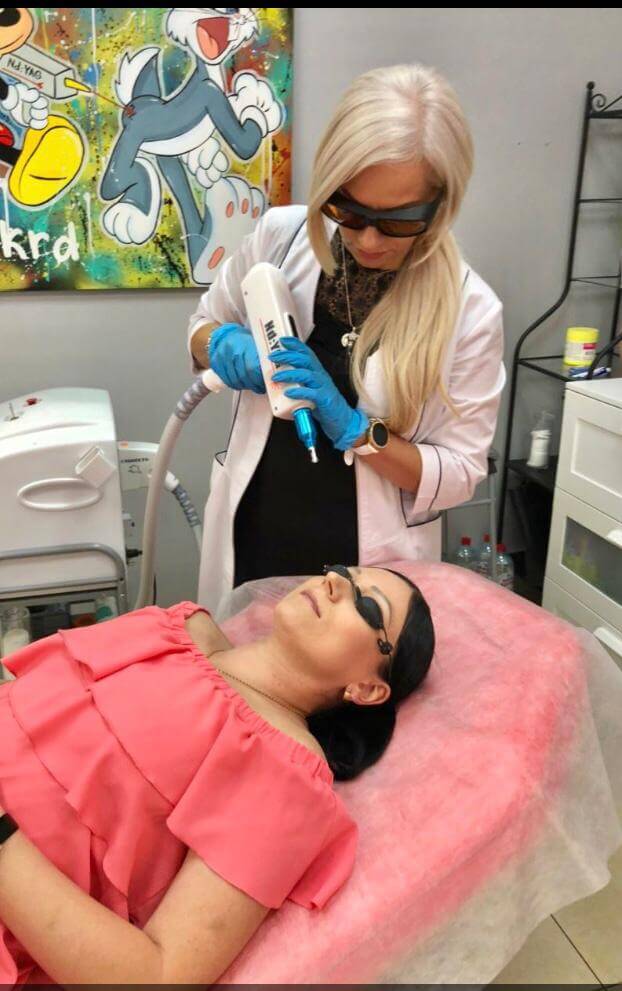

Natalia
г. Krasnodar expert in cosmetology
Ask a question
"Any dye has its purpose. Tattoo dye is not intended for work in the facial area - because a different technique is used during tattoo sessions. The dye is introduced into the deeper layers of the skin and will change color or float if it gets into the top layer. Unpredictable behavior in the epidermis is only a small part of what can happen after a session. If you read the composition, you will notice aggressive chemical compounds in it. Animal ingredients are the most dangerous - they cause complications in the form of severe allergic reactions and serious skin damage.
What does tint and durability depend on?
First of all, the shade of the permanent is directly influenced by your skin type - the same dye applied in the same technique will look different on different people. Take into account:
- peculiarities of hair growth;
- skin tone and type;
- the age of the client.
Secondly, the skin of the face is always more delicate and thinner, and its tone differs significantly from other parts of the body. The difference can be noticed by applying pigment to the face and, for example, to the hand. Under the influence of ultraviolet light, the color may also change slightly - to prevent this, it is worth using sunscreen.
Other factors that affect staying power and shade include:
- Care. It takes time for the epithelium to regenerate - so the client should avoid tanning and the use of grooming and cosmetic products. Failure to follow the master's recommendation, improper processing and peeling of crusts will lead to almost instant, uneven "loss" of paint.
- Palette. Dark permanent makeup pigments stay on the skin longer than light-colored dyes. Of course, it is impossible to achieve long-term preservation of the result by strongly diluting the paint.
- Quality of materials. Cheap dyes from little-known brands do not last long because of their dubious composition. Moreover, they are not safe. Even at the very beginning of the project, it is better to buy expensive, but high-quality consumables.
- Compliance with the technology of performance. A change in shade and unevenness are the typical consequences of the wrong introduction of pigment. The dye must get in deep enough to stay in the skin for a long time, but if it is too deeply injected, it can cause scarring.
Most important, of course, is the rehabilitation period. However, even the most meticulous care will not help if the beautician performed the procedure incorrectly.
Correction for several years after the application of permant is mandatory - its color will change with age, as well as the skin of the face itself. It does not cause much discomfort if the lines were applied "in their places" - for example, on the natural shape of the eyebrows, and not high above them.
Tips for the novice tattoo artist on the choice of paint
- Choose proven manufacturers - bright, saturated colors can be obtained only when using high-quality paints. The stingy pays twice, and the stingy master pays with his reputation.
- Black pigment runs out faster - feel free to take a large volume.
- Paints often dry out, so keep the thinner handy.
- If you are still undecided about technique and style, try ready-made kits, such as the Summer Set from KRASKA tattoo ink. The set contains 12 colors in 15 ml.
Our customers prefer the manufacturers: World Famous Tattoo Ink, Eternal Ink or KRASKA Tatoo Ink.
You can be sure of a great result by choosing these brands.
World Famous Tattoo Ink
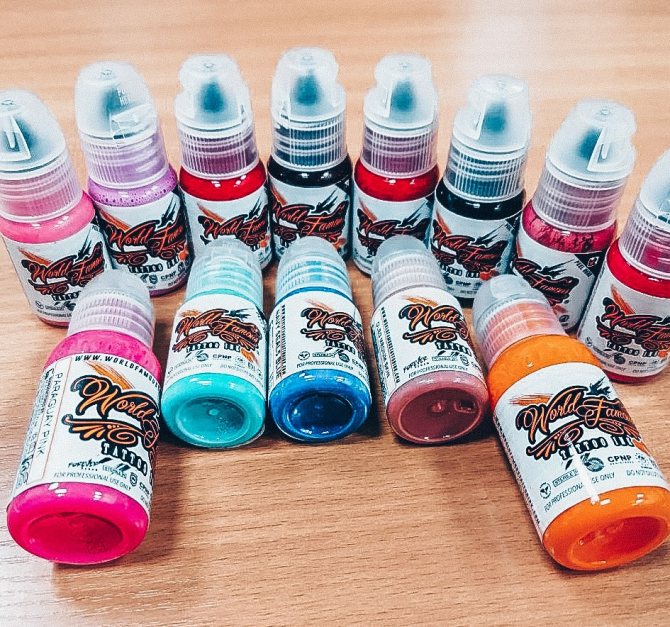

World Famous Tattoo Ink are some of the best on the global market. Most famous tattoo artists create their works with these very tattoo inks. Dense, thick pigment of the highest quality is presented in a wide color palette.
Choosing this brand of paint, you get more contrast, bold, bright and high-quality work. This is what distinguishes World Famous Tattoo Ink.
In our store we have a variety of sets as well as 15 and 30 ml bottles.
Tattoo Ink


Our Russian brand Tattoo Ink has already earned the respect and love of many tattoo artists.
Manufacturers, with a team of professional chemists and tattoo artists, conducted a detailed analysis of the top tattoo paints and developed a unique formulation, including the best and modern ingredients.
We have a variety of kits in our store, as well as 15, 30 ml bottles.
Eternal Ink


Tattoo ink created by craftsmen for craftsmen.
Eternal Ink does not need advertising. It is the world standard for tattoo ink.
Consistency of quality and color - the characteristic difference of this paint. The creators understand how critically important it is for the tattoo master, so they create just such a product.
What is iron oxide red?
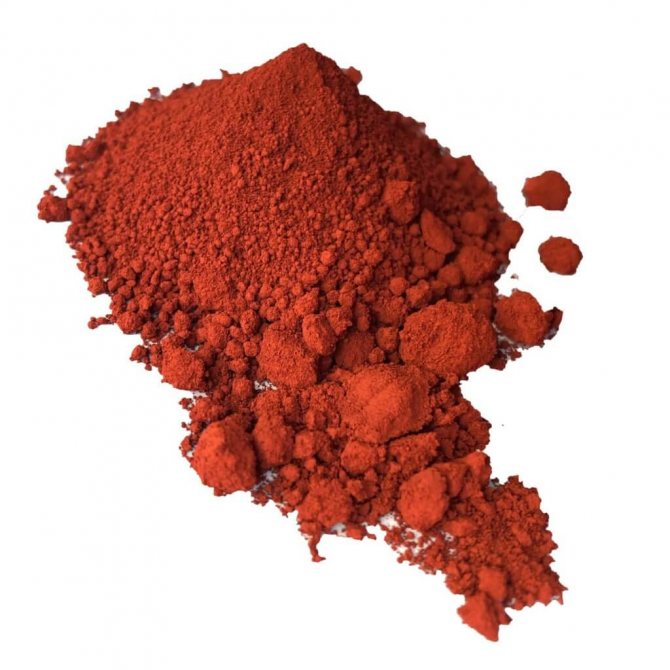

Iron oxide is a compound that is resistant to acids and alkalis and is found in various minerals. However, an identical counterpart produced chemically is used for the production of paints.
Non-toxic and long-lasting iron oxide dyes help to give eyebrows a natural and natural color. One of their main advantages is their easy blending and large palette (from ochre to red-brown).
Mineral pigments
The inorganic pigments most commonly used in tattooing include the following:
- chromium oxide;
- Iron oxides;
- Titanium dioxide.
Iron oxides in this list can be called the most valuable, because with their help you can get a variety of shades. Mineral pigments based on them are non-toxic and highly resistant. Iron-containing rocks of different colors - ochre, red, brown, and brown - are used in their production.
How do you distinguish organic from inorganic pigments?
In order not to make a mistake, ask an employee of the store where you are going to buy consumables for tattooing. Familiarize yourself with the composition on the label - it lists all the constituents of the paint. All inorganic pigment ingredient codes begin with the number "77".
- red iron oxide (77491);
- yellow iron oxide (77492);
- black (77499);
- orange iron oxide (77489);
- white titanium dioxide (77891)
Each of the elements has its own characteristics, properties and structure. To know exactly how the pigment will behave, how many approaches are needed and what the color migration will be, you need to take more time to study its composition.
Which pigments are better for the tattoo? It all depends on your preferred technique, as well as the characteristics of the client's skin. Most experienced beauticians use hybrid pigments, while beginners prefer artificial dyes. In the latter case, it is much easier to correct occasional mistakes - poorly painted area can be "cleaned up" with a laser.
According to masters, the most popular pigments for permanent makeup
Experienced cosmetologists recommend the products of not only European, but also some Russian brands. Below we will consider the best pigments for permanent makeup on the market.
Perma Blend pigments


These pigments for permanent makeup have long appeared on the Russian market - for more than five years, they are used by Russian beauticians. The company's products are constantly being tested and studied. It is believed that Perma Blend dyes are hypoallergenic, and the skin treated with them heals almost painlessly.
Pros and cons
high stability
no heavy metals and aromatic amines in the composition
environmental cleanliness and safety
to work with them requires a deep knowledge in coloring and sufficiently long experience
Tinel pigments
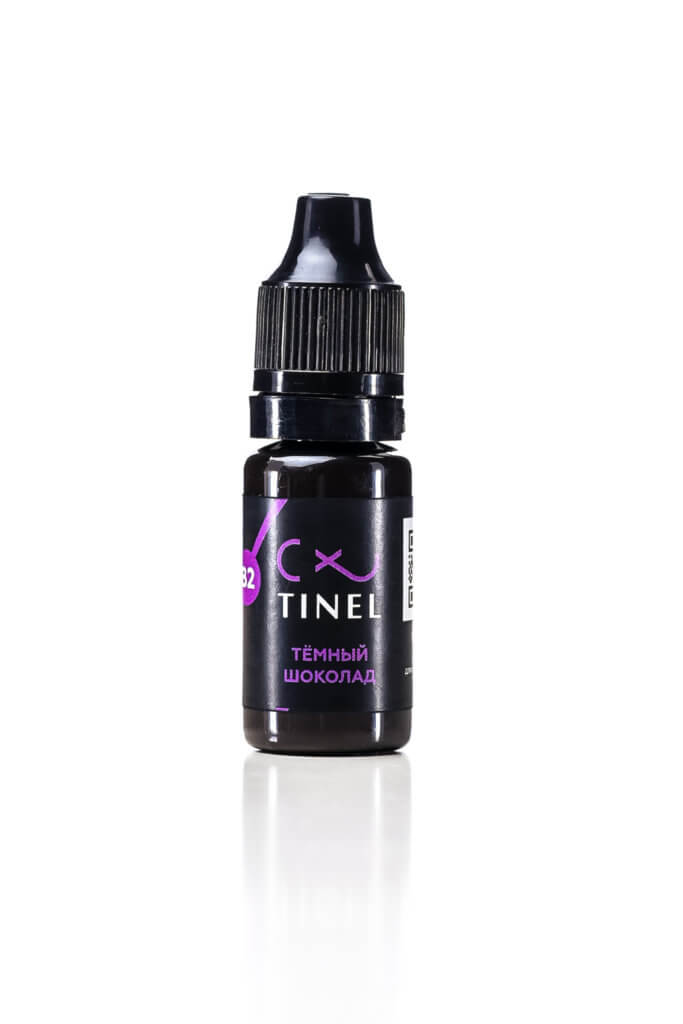

Tinel brand dyes provide a natural finish that will not fade into another color even after a year or two. These are completely organic pigments, gradually removed from the skin without unpleasant tinting. It does not need to be diluted before use - the paint is already ready to use and the shades are strictly according to the palette.
What is titanium dioxide?
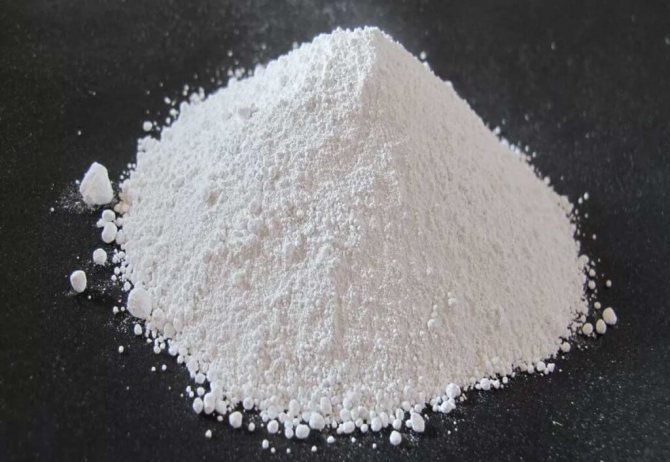

In the composition of some pigments for permanent makeup you can also see titanium dioxide - it is it that helps to give the paint a light, gentle shade. White dye is also found in minerals, but a chemical counterpart is used to make pigments.
The non-toxic, long-lasting pigment enhances the hiding power of organic paints, as well as dulling their color, making it softer and more natural.
Diluents
Working with paints is unthinkable without these thinners. Thinners are absolutely harmless and are used by painters in two cases: when it is necessary to dilute the thickened pigment or to make the color lighter. Diluents are used to achieve a shadow effect and smooth transitions using halftones.
Like the coloring pigment, the thinners must be made by a professional brand. Diluents from companies like Intenze or Solid are not a bad solution. Both are mid-priced brands that produce thinners comparable to any paint. In addition, you can order the thinner of the same brand as the pigment at once. This will ensure full consistency of chemical compositions.
How to choose ink for tattoos?
Fortunately, these days, a beginner or experienced artist can pick up a high-quality set of ink for tattoos, rather than looking for pigments individually. This is a complete collection of all the colors you need in an easy to store and use kit. Plus, it is offered at a more reasonable price.
However, that's not the only benefit of buying a kit. It also means that you can use a greater variety of colors, as all people have different tastes and preferences.


Some people will prefer dark, moody and dramatic tattoos, while others will like brighter drawings, such as old-school
If the tattoo fades too quickly, it can be a problem for both the tattoo artist and the client. In addition, you may lose the trust of your customers and earn a bad reputation through negative reviews.
Before you buy tattoo mascara, pay attention to the following things:
- Ingredients. The first thing to look at is the composition of the tattoo ink. Since tattoo mascara can cause allergic reactions, it's fair to use brands that use natural and organic ingredients. Avoid any brands that do not disclose the composition;
- Pigment compatibility. There are cases when tattoo ink, or rather pigments from different manufacturers, react negatively with each other. That is why it is recommended to buy ink for tattoos from one brand, then you will know that all colors will blend well with each other;
- Brand Reputation. For a beginner, all tattoo ink looks almost the same. However, experienced tattoo artists will tell you that this is far from the case. Therefore, in order to avoid unpleasant consequences, it is better to avoid cheap and unknown brands;
- Country of origin. You also need to check the country of origin of the paint. This will help you determine whether it complies with the rules and regulations of the Russian Federation in terms of health and safety.

